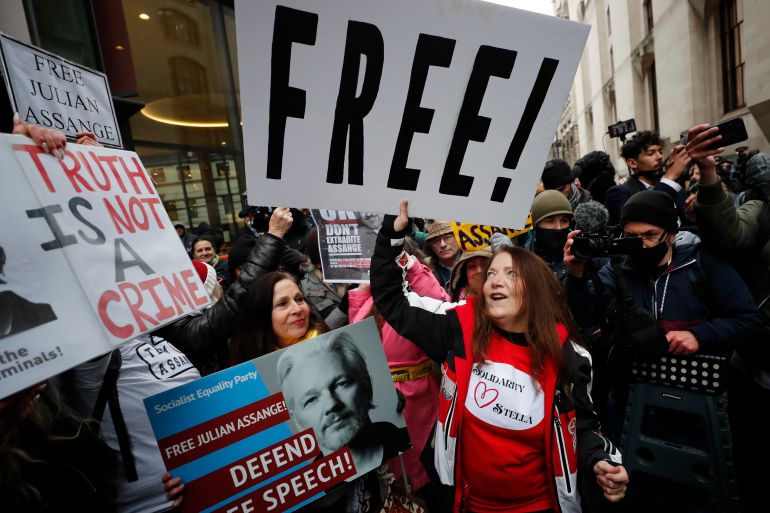Julian Assange timeline: Computer programmer to cause celebre
Assange’s supporters see him as a symbol of press freedom, while US officials accuse him of being an enemy of the state.

WikiLeaks founder Julian Assange’s legal battle has resumed in the United Kingdom.
Here are some key events and details in his life to date:
July 1971 – Assange is born in Townsville, Australia, to a mother and stepfather involved in theatre. As a teenager, he gains a reputation as a computer programmer, and in 1995 is fined for computer hacking but avoids prison on condition he does not offend again.
2006 – Founds WikiLeaks, creating an internet-based “dead letter drop” for leakers of classified or sensitive information.
April 5, 2010 – WikiLeaks releases leaked video from a US helicopter showing an air raid that killed civilians in Baghdad, Iraq, including two Reuters news agency staff.
July 25, 2010 – WikiLeaks releases more than 91,000 documents, mostly secret US military reports about the Afghanistan war.
October 2010 – WikiLeaks releases 400,000 classified military files chronicling the Iraq war. The next month, it releases thousands of US diplomatic cables, including candid views of foreign leaders and blunt assessments of security threats.
November 18, 2010 – A Swedish court orders Assange’s arrest over rape allegations, which he denies. He is arrested in the UK the next month on a European Arrest Warrant but freed on bail.
February 2011 – London’s Westminster Magistrates Court orders Assange’s extradition to Sweden. He appeals.
June 14, 2012 – The British Supreme Court rejects Assange’s final appeal and five days later he takes refuge in Ecuador’s embassy in London and seeks political asylum, which Ecuador grants in August 2012.
April 13, 2017 – US Secretary of State Mike Pompeo, then CIA chief, describes WikiLeaks as “a non-state hostile intelligence service often abetted by state actors like Russia”.
May 19, 2017 – Swedish prosecutors discontinue their investigation, saying it is impossible to proceed while Assange is in the Ecuadorean embassy.
April 11, 2019 – Assange is carried out of the embassy and arrested after Ecuador revokes his political asylum. He is sentenced on May 1 to 50 weeks in prison by a British court for skipping bail. He completes the sentence early but remains jailed pending extradition hearings.
May 13, 2019 – Swedish prosecutors reopen their investigation and say they will seek Assange’s extradition to Sweden.
June 11, 2019 – The US Justice Department formally asks Britain to extradite Assange to the United States to face charges that he conspired to hack US government computers and violated an espionage law.
November 19, 2019 – Swedish prosecutors drop their rape investigation, saying the evidence is not strong enough to bring charges, in part because of the passage of time.
February 21, 2020 – A London court begins the first part of extradition hearings which are adjourned after a week. The hearings are supposed to resume in May but are delayed until September because of the COVID-19 pandemic.
January 4, 2021 – At the Old Bailey in London, Judge Vanessa Baraitser concludes it would be “oppressive” to extradite him to the US because of his frail mental health, saying there was a real risk he would take his own life.
January 6, 2021 – Judge Baraitser denies Assange bail at a London court, saying he is a flight risk.